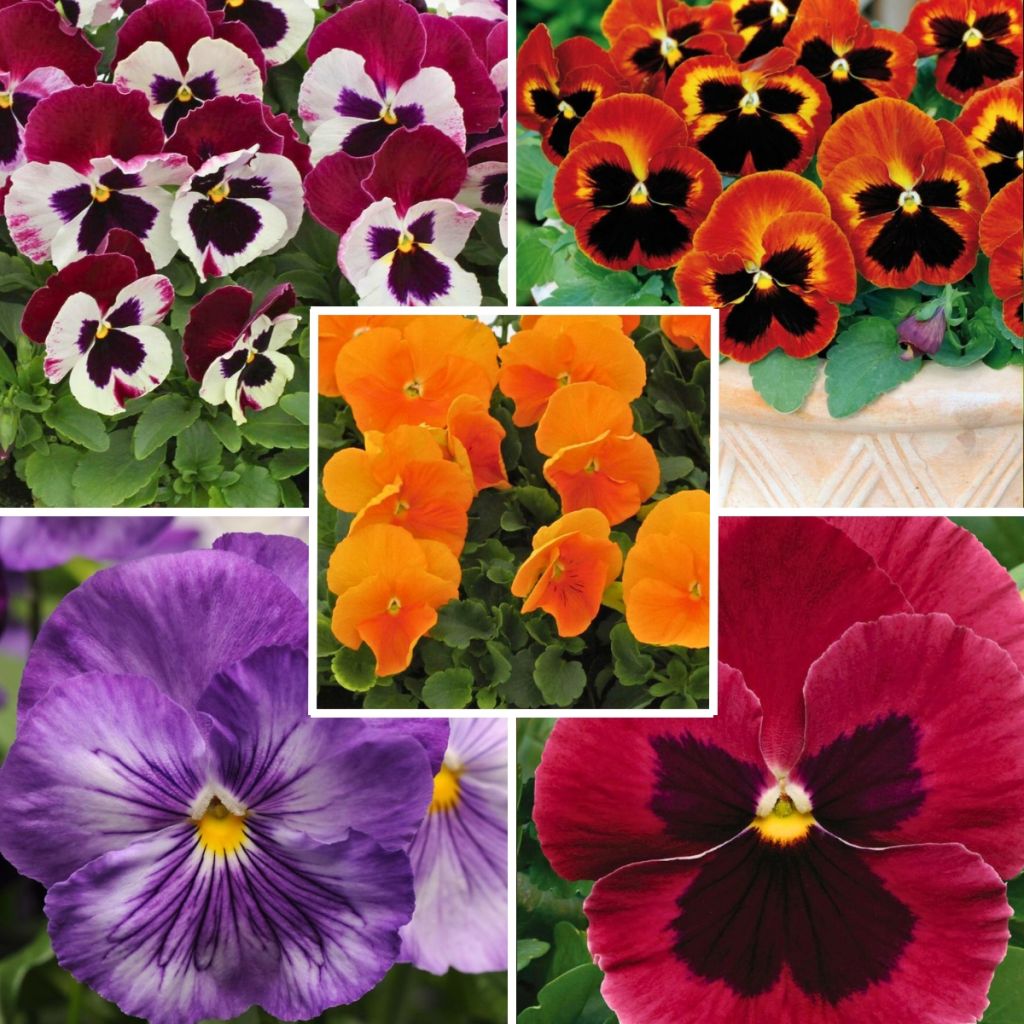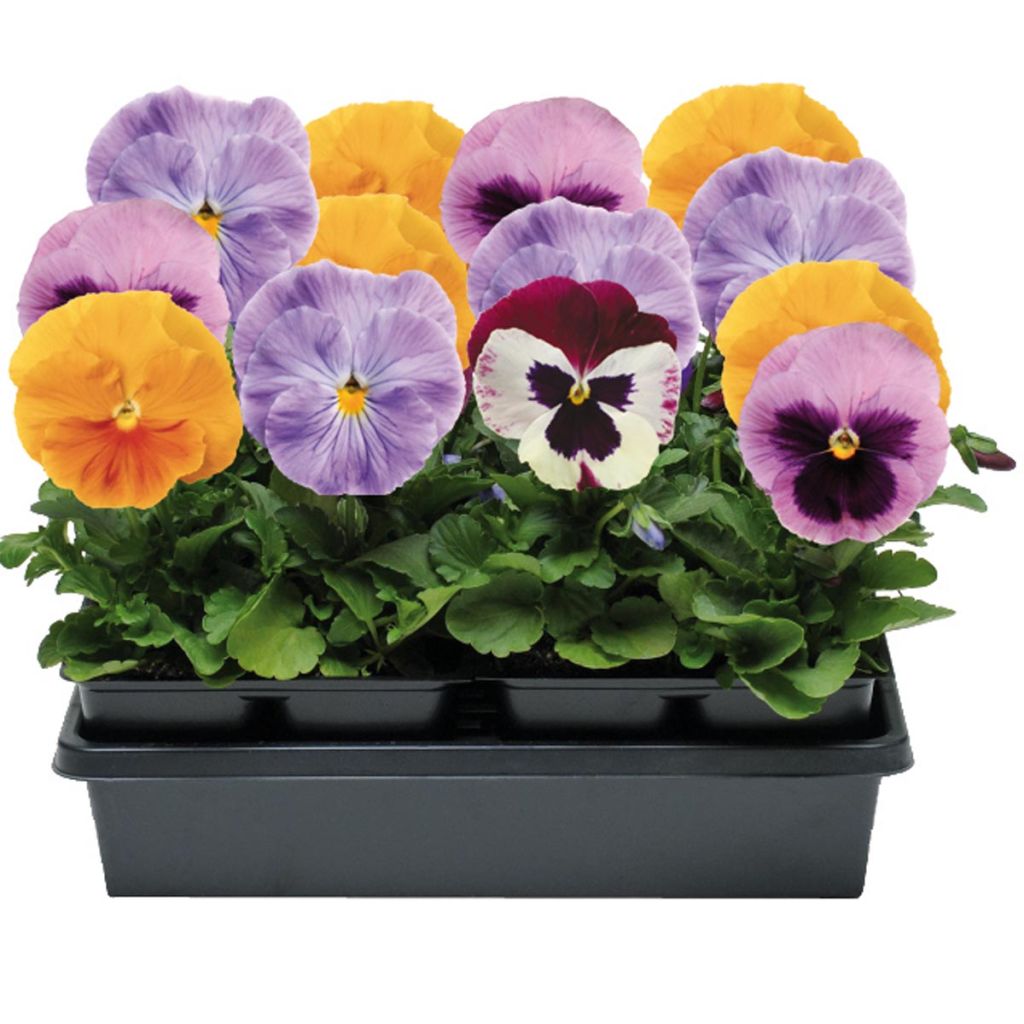

Collection of 5 Matrix Pansy Spice Mix Plug Plants


Collection of 5 Matrix Pansy Spice Mix Plug Plants
Collection of 5 Matrix Pansy Spice Mix Plug Plants
I am disappointed by these really tiny young plants, without any flowers. The photos misled me. Transplanting into a bucket will be necessary before planting. Unfortunately, I doubt the chances of successful growth.
Solange , 30/10/2024
This plant carries a 6 months recovery warranty
More information
We guarantee the quality of our plants for a full growing cycle, and will replace at our expense any plant that fails to recover under normal climatic and planting conditions.
From €5.90 for pickup delivery and €6.90 for home delivery
Express home delivery from €8.90.
Does this plant fit my garden?
Set up your Plantfit profile →
Collection items (5 plants)
Description
The Matrix Spice Mix Pansy Collection blooms in a variety of colours, creating a fantastic effect in the garden or in containers. The medium-sized flowers are solid or bicoloured, with or without black macules. They come in shades of orange or blackcurrant, with various tones of lavender and pink. They bloom for a very long period of time. The plants are compact, floriferous, and resistant to cold, diseases, and heat. This variety regrows well in spring and does not bolt with the first heat, ensuring a long and high-quality flowering period. It is easy to grow in humus-bearing and moist soil, in a sunny or partially shaded location.
The collection includes:
1 plug plant of Medium-sized Pansy Matrix Cassis
1 plug plant of Medium-sized Pansy Matrix Deep Blue Blotch
1 plug plant of Medium-sized Pansy Matrix Lavender Shades
1 plug plant of Medium-sized Pansy Matrix Deep Orange
1 plug plant of Medium-sized Pansy Matrix Alpha Solar Flare
Garden pansies, sometimes called giant Swiss pansies, are actually hybrids grouped under Viola x wittrockiana. They belong to the violet family and are mostly grown as annuals or biennials, although they are theoretically perennial but short-lived. The 'Matrix F1 Spice Mix' variety produces ramified plants that quickly form compact clumps, with a slightly spreading habit, reaching 20cm (8in) in height and 20 to 30cm (8 to 12in) in width. They bloom from late winter to late spring, or from late spring to late summer. The 'Matrix F1 Spice Mix' pansies offer medium-sized flowers, with a diameter of 4 to 5cm (2in), that are fully open. Some of them are solid in bright orange or lavender, while others combine white petals with pink petals of varying shades, up to purple. Depending on the plants, they may or may not have 3 black macules at the base of the petals, surrounding a tiny bright yellow and white centre. The medium green leaves are elliptical and broadly crenate.
If you love them in the garden, plant them in containers on the windowsill so you can enjoy them up close while staying warm. Play with colours and combine pansies with primroses, wallflowers, grape hyacinths, daisies... and even with grasses like Japanese sedge for a graphic effect in a contemporary style. In the garden, associate them with Heucheras and tulips. The blue-green colour of glaucous fescues also complements them well.
Pansy petals are edible and their colours will add a touch of originality to your salads and pastries. To do this, grow them as you would your vegetables, as naturally as possible.
Note: Please be aware that our plug plants are professional products intended for experienced gardeners: upon receipt, transplant them as soon as possible, either in containers, window boxes, or directly in flower beds.
Report an error about the product description
Flowering
Foliage
Plant habit
Botanical data
Cultivar or hybrid
Planting and care
Plant your plug plants of biennials in a pot or a large container, in a sunny position or possibly partial shade. They need a light and humus-rich soil and appreciate a fertilizer. In a pot, biennials must be watered at planting, you can store them during winter on a balcony or a window sill protected from cold winds.
Planting period
Intended location
Care
-
, onOrder confirmed
Reply from on Promesse de fleurs
Haven't found what you were looking for?
Hardiness is the lowest winter temperature a plant can endure without suffering serious damage or even dying. However, hardiness is affected by location (a sheltered area, such as a patio), protection (winter cover) and soil type (hardiness is improved by well-drained soil).

Photo Sharing Terms & Conditions
In order to encourage gardeners to interact and share their experiences, Promesse de fleurs offers various media enabling content to be uploaded onto its Site - in particular via the ‘Photo sharing’ module.
The User agrees to refrain from:
- Posting any content that is illegal, prejudicial, insulting, racist, inciteful to hatred, revisionist, contrary to public decency, that infringes on privacy or on the privacy rights of third parties, in particular the publicity rights of persons and goods, intellectual property rights, or the right to privacy.
- Submitting content on behalf of a third party;
- Impersonate the identity of a third party and/or publish any personal information about a third party;
In general, the User undertakes to refrain from any unethical behaviour.
All Content (in particular text, comments, files, images, photos, videos, creative works, etc.), which may be subject to property or intellectual property rights, image or other private rights, shall remain the property of the User, subject to the limited rights granted by the terms of the licence granted by Promesse de fleurs as stated below. Users are at liberty to publish or not to publish such Content on the Site, notably via the ‘Photo Sharing’ facility, and accept that this Content shall be made public and freely accessible, notably on the Internet.
Users further acknowledge, undertake to have ,and guarantee that they hold all necessary rights and permissions to publish such material on the Site, in particular with regard to the legislation in force pertaining to any privacy, property, intellectual property, image, or contractual rights, or rights of any other nature. By publishing such Content on the Site, Users acknowledge accepting full liability as publishers of the Content within the meaning of the law, and grant Promesse de fleurs, free of charge, an inclusive, worldwide licence for the said Content for the entire duration of its publication, including all reproduction, representation, up/downloading, displaying, performing, transmission, and storage rights.
Users also grant permission for their name to be linked to the Content and accept that this link may not always be made available.
By engaging in posting material, Users consent to their Content becoming automatically accessible on the Internet, in particular on other sites and/or blogs and/or web pages of the Promesse de fleurs site, including in particular social pages and the Promesse de fleurs catalogue.
Users may secure the removal of entrusted content free of charge by issuing a simple request via our contact form.
The flowering period indicated on our website applies to countries and regions located in USDA zone 8 (France, the United Kingdom, Ireland, the Netherlands, etc.)
It will vary according to where you live:
- In zones 9 to 10 (Italy, Spain, Greece, etc.), flowering will occur about 2 to 4 weeks earlier.
- In zones 6 to 7 (Germany, Poland, Slovenia, and lower mountainous regions), flowering will be delayed by 2 to 3 weeks.
- In zone 5 (Central Europe, Scandinavia), blooming will be delayed by 3 to 5 weeks.
In temperate climates, pruning of spring-flowering shrubs (forsythia, spireas, etc.) should be done just after flowering.
Pruning of summer-flowering shrubs (Indian Lilac, Perovskia, etc.) can be done in winter or spring.
In cold regions as well as with frost-sensitive plants, avoid pruning too early when severe frosts may still occur.
The planting period indicated on our website applies to countries and regions located in USDA zone 8 (France, United Kingdom, Ireland, Netherlands).
It will vary according to where you live:
- In Mediterranean zones (Marseille, Madrid, Milan, etc.), autumn and winter are the best planting periods.
- In continental zones (Strasbourg, Munich, Vienna, etc.), delay planting by 2 to 3 weeks in spring and bring it forward by 2 to 4 weeks in autumn.
- In mountainous regions (the Alps, Pyrenees, Carpathians, etc.), it is best to plant in late spring (May-June) or late summer (August-September).
The harvesting period indicated on our website applies to countries and regions in USDA zone 8 (France, England, Ireland, the Netherlands).
In colder areas (Scandinavia, Poland, Austria...) fruit and vegetable harvests are likely to be delayed by 3-4 weeks.
In warmer areas (Italy, Spain, Greece, etc.), harvesting will probably take place earlier, depending on weather conditions.
The sowing periods indicated on our website apply to countries and regions within USDA Zone 8 (France, UK, Ireland, Netherlands).
In colder areas (Scandinavia, Poland, Austria...), delay any outdoor sowing by 3-4 weeks, or sow under glass.
In warmer climes (Italy, Spain, Greece, etc.), bring outdoor sowing forward by a few weeks.








































